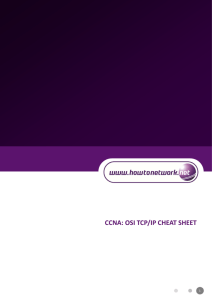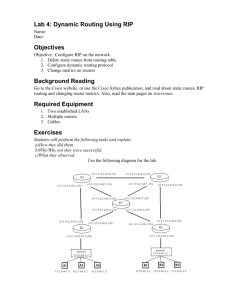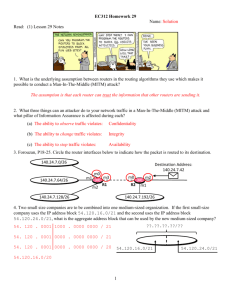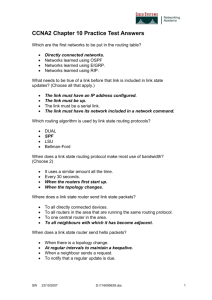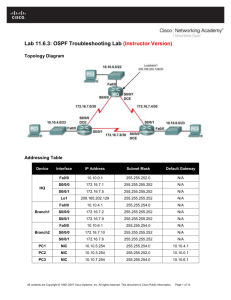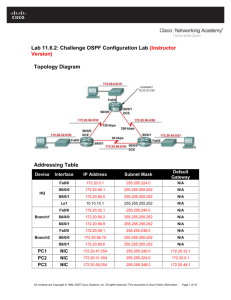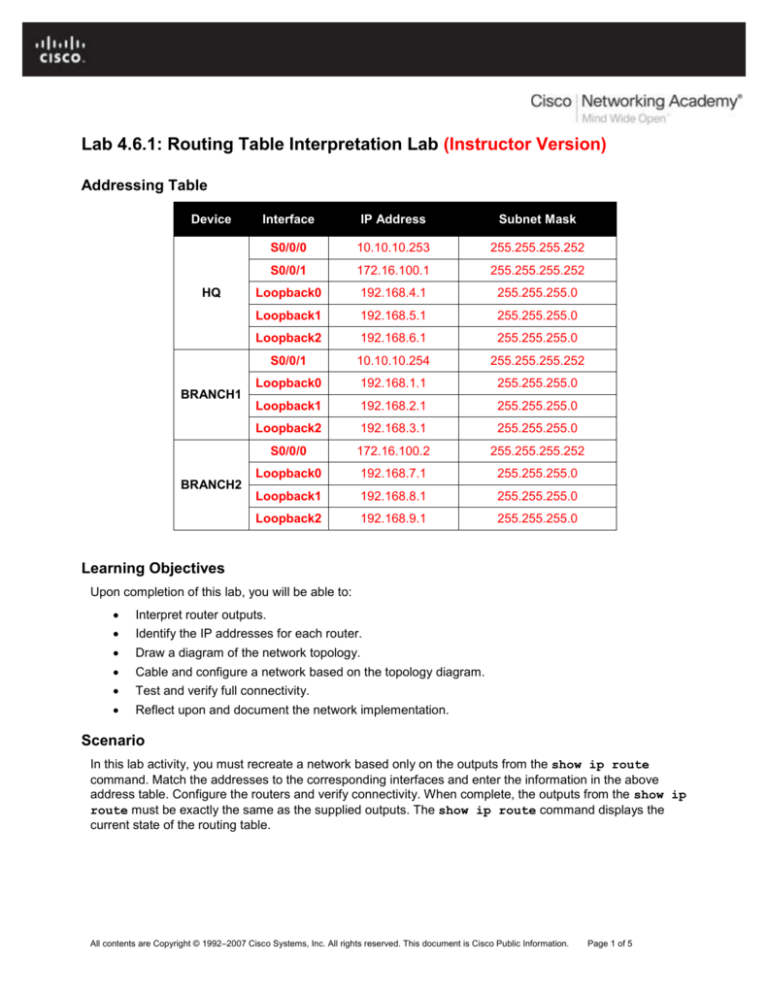
Lab 4.6.1: Routing Table Interpretation Lab (Instructor Version)
Addressing Table
Device
HQ
BRANCH1
BRANCH2
Interface
IP Address
Subnet Mask
S0/0/0
10.10.10.253
255.255.255.252
S0/0/1
172.16.100.1
255.255.255.252
Loopback0
192.168.4.1
255.255.255.0
Loopback1
192.168.5.1
255.255.255.0
Loopback2
192.168.6.1
255.255.255.0
S0/0/1
10.10.10.254
255.255.255.252
Loopback0
192.168.1.1
255.255.255.0
Loopback1
192.168.2.1
255.255.255.0
Loopback2
192.168.3.1
255.255.255.0
S0/0/0
172.16.100.2
255.255.255.252
Loopback0
192.168.7.1
255.255.255.0
Loopback1
192.168.8.1
255.255.255.0
Loopback2
192.168.9.1
255.255.255.0
Learning Objectives
Upon completion of this lab, you will be able to:
Interpret router outputs.
Identify the IP addresses for each router.
Draw a diagram of the network topology.
Cable and configure a network based on the topology diagram.
Test and verify full connectivity.
Reflect upon and document the network implementation.
Scenario
In this lab activity, you must recreate a network based only on the outputs from the show ip route
command. Match the addresses to the corresponding interfaces and enter the information in the above
address table. Configure the routers and verify connectivity. When complete, the outputs from the show ip
route must be exactly the same as the supplied outputs. The show ip route command displays the
current state of the routing table.
All contents are Copyright © 1992–2007 Cisco Systems, Inc. All rights reserved. This document is Cisco Public Information.
Page 1 of 5
CCNA Exploration
Routing Protocols and Concepts:
Distance Vector Routing Protocols
Lab 4.6.1: Routing Table Interpretation Lab
Task 1: Examine the router outputs.
Step 1: Examine the output from the HQ router.
HQ#show ip route
Codes: C - connected, S - static, I - IGRP, R - RIP, M - mobile, B – BGP
D - EIGRP, EX - EIGRP external, O - OSPF, IA - OSPF inter area
N1 - OSPF NSSA external type 1, N2 - OSPF NSSA external type 2
E1 - OSPF external type 1, E2 - OSPF external type 2, E – EGP
i - IS-IS, L1 - IS-IS level-1, L2 - IS-IS level-2, ia - IS-IS inter area
* - candidate default, U - per-user static route, o – ODR
P - periodic downloaded static route
Gateway of last resort is not set
C
C
R
R
R
C
C
C
R
R
R
10.0.0.0/30 is subnetted, 1 subnets
10.10.10.252 is directly connected, Serial0/0/0
172.16.0.0/30 is subnetted, 1 subnets
172.16.100.0 is directly connected, Serial0/0/1
192.168.1.0/24 [120/1] via 10.10.10.254, 00:00:03,
192.168.2.0/24 [120/1] via 10.10.10.254, 00:00:03,
192.168.3.0/24 [120/1] via 10.10.10.254, 00:00:03,
192.168.4.0/24 is directly connected, Loopback0
192.168.5.0/24 is directly connected, Loopback1
192.168.6.0/24 is directly connected, Loopback2
192.168.7.0/24 [120/1] via 172.16.100.2, 00:00:04,
192.168.8.0/24 [120/1] via 172.16.100.2, 00:00:04,
192.168.9.0/24 [120/1] via 172.16.100.2, 00:00:04,
Serial0/0/0
Serial0/0/0
Serial0/0/0
Serial0/0/1
Serial0/0/1
Serial0/0/1
Step 2: Examine the output from the BRANCH1 router.
BRANCH1#show ip route
Codes: C - connected, S - static, I - IGRP, R - RIP, M - mobile, B – BGP
D - EIGRP, EX - EIGRP external, O - OSPF, IA - OSPF inter area
N1 - OSPF NSSA external type 1, N2 - OSPF NSSA external type 2
E1 - OSPF external type 1, E2 - OSPF external type 2, E – EGP
i - IS-IS, L1 - IS-IS level-1, L2 - IS-IS level-2, ia - IS-IS inter area
* - candidate default, U - per-user static route, o – ODR
P - periodic downloaded static route
Gateway of last resort is not set
C
R
C
C
C
R
R
R
R
R
R
10.0.0.0/30 is subnetted, 1 subnets
10.10.10.252 is directly connected, Serial0/0/0
172.16.0.0/16 [120/1] via 10.10.10.253, 00:00:04, Serial0/0/0
192.168.1.0/24 is directly connected, Loopback0
192.168.2.0/24 is directly connected, Loopback1
192.168.3.0/24 is directly connected, Loopback2
192.168.4.0/24 [120/1] via 10.10.10.253, 00:00:04, Serial0/0/0
192.168.5.0/24 [120/1] via 10.10.10.253, 00:00:04, Serial0/0/0
192.168.6.0/24 [120/1] via 10.10.10.253, 00:00:04, Serial0/0/0
192.168.7.0/24 [120/2] via 10.10.10.253, 00:00:04, Serial0/0/0
192.168.8.0/24 [120/2] via 10.10.10.253, 00:00:04, Serial0/0/0
192.168.9.0/24 [120/2] via 10.10.10.253, 00:00:04, Serial0/0/0
All contents are Copyright © 1992–2007 Cisco Systems, Inc. All rights reserved. This document is Cisco Public Information.
Page 2 of 5
CCNA Exploration
Routing Protocols and Concepts:
Distance Vector Routing Protocols
Lab 4.6.1: Routing Table Interpretation Lab
Step 3: Examine the output from the BRANCH2 router.
BRANCH2#show ip route
Codes: C - connected, S - static, I - IGRP, R - RIP, M - mobile, B – BGP
D - EIGRP, EX - EIGRP external, O - OSPF, IA - OSPF inter area
N1 - OSPF NSSA external type 1, N2 - OSPF NSSA external type 2
E1 - OSPF external type 1, E2 - OSPF external type 2, E – EGP
i - IS-IS, L1 - IS-IS level-1, L2 - IS-IS level-2, ia - IS-IS inter area
* - candidate default, U - per-user static route, o – ODR
P - periodic downloaded static route
Gateway of last resort is not set
R
C
R
R
R
R
R
R
C
C
C
10.0.0.0/8 [120/1] via 172.16.100.1, 00:00:19, Serial0/0/1
172.16.0.0/30 is subnetted, 1 subnets
172.16.100.0 is directly connected, Serial0/0/1
192.168.1.0/24 [120/2] via 172.16.100.1, 00:00:19, Serial0/0/1
192.168.2.0/24 [120/2] via 172.16.100.1, 00:00:19, Serial0/0/1
192.168.3.0/24 [120/2] via 172.16.100.1, 00:00:19, Serial0/0/1
192.168.4.0/24 [120/1] via 172.16.100.1, 00:00:19, Serial0/0/1
192.168.5.0/24 [120/1] via 172.16.100.1, 00:00:19, Serial0/0/1
192.168.6.0/24 [120/1] via 172.16.100.1, 00:00:19, Serial0/0/1
192.168.7.0/24 is directly connected, Loopback0
192.168.8.0/24 is directly connected, Loopback1
192.168.9.0/24 is directly connected, Loopback2
Task 2: Create a diagram of the network based on the router outputs.
Step 1: Draw a diagram of the network based on your interpretation of the router outputs in the space
provided below.
Topology Diagram
All contents are Copyright © 1992–2007 Cisco Systems, Inc. All rights reserved. This document is Cisco Public Information.
Page 3 of 5
CCNA Exploration
Routing Protocols and Concepts:
Distance Vector Routing Protocols
Lab 4.6.1: Routing Table Interpretation Lab
Step 2: Document the interface addresses in the Addressing Table.
Task 3: Create the network.
Step 1: Cable a network that is similar to the one in the Topology Diagram.
You can use any current router in your lab as long as it has the required interfaces shown in the topology.
Note: If you use 1700, 2500, or 2600 routers, the router outputs and interface descriptions will appear
different.
Step 2: Clear any existing configurations on the routers.
Step 3: Configure the HQ, BRANCH1, and BRANCH2 routers.
Configure the interfaces on the HQ, BRANCH1, and BRANCH2 routers with the IP addresses from the
Addressing Table. The clock rate, DTE assignment, and DCE assignment of the Serial interfaces are at your
discretion.
Task 4: Configure the routing protocol for each router.
Step 1: Enable the RIP routing protocol on the BRANCH1 router.
The RIP routing protocol will be used to advertise directly connected networks to the other routers in the
topology. RIP configuration will be covered in greater detail in a later lab activity. The basic configuration
steps necessary for this lab activity are provided below.
To enable RIP, enter global configuration mode and use the router rip command.
BRANCH1(config)#router rip
BRANCH1(config-router)#
Step 2: Enter the classful network addresses for each directly connected network.
Once you are in routing configuration mode, enter the classful network address for each directly connected
network, using the network command. An example of the use of the network command is provided below.
BRANCH1(config-router)#network 192.168.1.0
BRANCH1(config-router)#
Be sure to configure a network statement for each network that is attached to a Serial or Loopback interface
of the router.
When you are finished with the RIP configuration, return to privileged EXEC mode and save the current
configuration to NVRAM.
BRANCH1(config-router)#end
%SYS-5-CONFIG_I: Configured from console by console
BRANCH1#copy run start
All contents are Copyright © 1992–2007 Cisco Systems, Inc. All rights reserved. This document is Cisco Public Information.
Page 4 of 5
CCNA Exploration
Routing Protocols and Concepts:
Distance Vector Routing Protocols
Lab 4.6.1: Routing Table Interpretation Lab
Step 3: Configure RIP on the HQ and BRANCH2 routers.
Use the router rip and network commands to configure the HQ and BRANCH2 routers to advertise
directly connected networks to the other routers in the topology.
When you are finished with the RIP configuration, return to privileged EXEC mode and save the current
configuration to NVRAM.
Step 4: Test and verify connectivity.
Use the ping command to verify that the router interfaces can communicate with each other. If you discover
that two interfaces cannot ping each other, troubleshoot your IP addressing and router configuration.
Task 5: Document the Router Configurations
On each router, capture the following command output to a text file and save for future reference:
Running configuration
Routing table – The output of the show ip route command for each of the routers should be
exactly the same as the provided outputs
Interface summarization
Task 6: Clean Up
Erase the configurations and reload the routers. Disconnect and store the cabling. For PC hosts that are
normally connected to other networks (such as the school LAN or to the Internet), reconnect the appropriate
cabling and restore the TCP/IP settings.
All contents are Copyright © 1992–2007 Cisco Systems, Inc. All rights reserved. This document is Cisco Public Information.
Page 5 of 5





